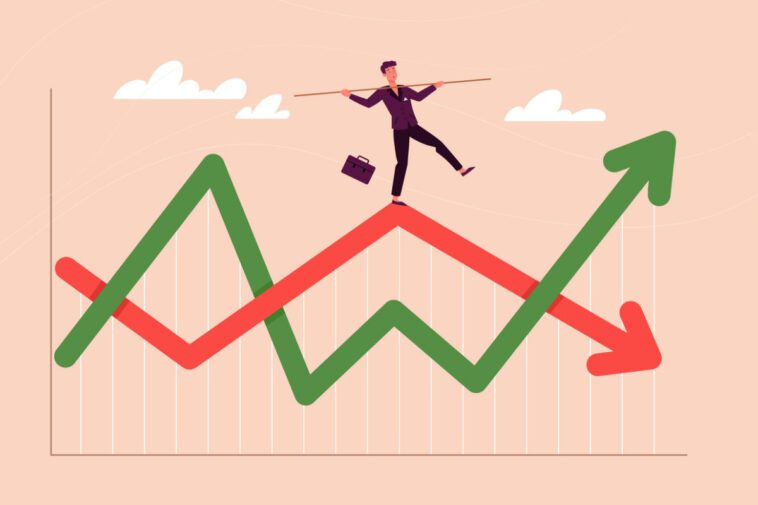Whether you’re paying off debt, saving for the future or buying a home, you should be aware of interest rates and how they affect your financial plans. These rates are affected by the Federal funds rate and can vary greatly.
Inflation leads to higher interest rates
Increasing inflation is a major problem for the economy. It can hurt businesses, hurt people who can’t keep up with the rising cost of living, and erode long-term savings. It’s important to understand the relationship between inflation and interest rates.
The Federal Reserve increases short-term interest rates to regulate the money supply. The Fed does this to maintain a consistent level of demand in the economy.
High inflation makes it difficult for businesses to set prices, and for consumers to plan their purchases. It can also create job losses. In extreme situations, it can lead to hyperinflation, a condition where prices are uncontrollable.
Inflation is a redistribution of purchasing power from savers to borrowers. It occurs over time and affects everyone.
Inflation may be caused by a government’s inability to raise taxes. It also may be caused by increased imports. In some cases, it may also occur in the context of geopolitical instability, which can be a big market disruptor.
While inflation and interest rates aren’t always the same thing, they are closely linked. When interest rates are high, consumers are less likely to borrow and spend. And they spend more time researching the best deals. When interest rates are low, consumers are more likely to borrow and spend.
Inflation and interest rates can have a big impact on investments and long-term savings. It’s important for investors to recognize red flags.
Savings account yields
Despite the fact that the Federal Reserve has kept interest rates on hold for most of the last decade, the savings account yield has been on the rise. The Federal Reserve has announced that it is considering raising interest rates multiple times over the course of the next few years.
The highest savings account yields currently exceed 3.5%. There is a small but growing contingent of banks that have resisted the trend and are keeping rates low. This is in part due to the fact that interest rates on debt have risen due to high inflation. Likewise, savings accounts at financial institutions carry less risk of losing principal balances than other types of accounts.
The best savings accounts offer easy access and flexibility. This can be particularly handy in an economic crisis where you need money immediately. You can also get more interest by having a larger balance. In the meantime, keep in mind that there are other accounts you may want to consider.
The Fed is also planning to raise the federal funds rate multiple times over the course of the next few months. This is not an insignificant decision as the federal funds rate directly affects the cost of borrowing money at night. In addition to this, the Fed is considering raising interest rates to combat high inflation. This is a big change in the federal government’s long-term plans, as inflation has been running high for years.
Student loan interest rates vary by type
Depending on the type of student loan you apply for, interest rates may vary. You’ll need to consider your loan type as well as the repayment options available.
There are a few different types of student loans, including federal, private, and subsidized. Each type has different interest rates, which can be affected by the economy.
Subsidized loans are a type of federal loan that are paid for by the government. These loans include interest that is paid by the government when the funds are received and during the grace period. The interest accrues during this period and will be added to the balance of the loan once the repayment period begins. Unsubsidized loans are a type of federal loan that do not include this interest. These loans have accruing interest as soon as the funds are disbursed.
These loans can have a higher interest rate than subsidized loans. Some lenders will take into account your academic history and your income when determining your rate.
You can get a lower student loan interest rate if you can find a co-signer with good credit. The co-signer becomes responsible for your loan in the event that you are unable to make payments.
The Federal Reserve recently raised interest rates. The increase in rates is affecting both new and existing private loans. You can also negotiate a lower interest rate with your current loan servicer.
Federal funds rate affects interest rates that banks charge for loan products
Depending on the federal funds rate, the interest rates on many loan products such as savings accounts, CDs, and credit cards are affected. When the federal funds rate is low, the interest rates are lower. However, when the fed funds rate is high, the interest rates are higher.
Federal funds rate is the interest rate that commercial banks charge each other for lending short-term cash. It is a key tool used by the Federal Reserve to influence the economy. It affects interest rates on various lending products, including credit cards, auto loans, home equity lines of credit, mortgages, and more.
The Fed Open Market Committee (FOMC) sets the federal funds rate. They meet eight times a year and decide the target range for the federal funds rate. When the federal funds rate is higher than the target, the banks can charge more than the target for their loans. Typically, banks set the interest rate at the midpoint of the target.
The Federal Reserve can raise the federal funds rate by increasing the IORB, or the interest rate on reserve balances. The Fed can also decrease the federal funds rate by taking money out of the system, or adding money.
The prime rate is the interest rate that banks charge for loans to the most creditworthy borrowers. It is determined by the riskiness of the borrower and the bank’s profitability. The prime rate is usually about three percentage points above the federal funds rate.
Taking out a loan when interest rates are high means you’ll need to pay more
Taking out a loan is no small feat. The best way to go about it is to make smart decisions, ie don’t sweat it. The best way to make smart decisions is to have an open mind and a flexible budget. If you are in the market for a mortgage, make sure to shop around. This will ensure that you get the best rate, and save you money in the process. If you are looking for a mortgage lender, make sure to check out a couple of websites, and read the reviews before making your decision. The best lenders will be happy to talk you through the process, and will be more than happy to provide the best interest rate.
Lowering interest rates can give the economy a short-term boost
Changing interest rates can have a significant effect on the economy, both directly and indirectly. It affects consumer spending, investment, and even inflation. Understanding the relationship between interest rates and the economy can help you make better financial decisions.
A low federal funds rate makes it cheaper to borrow money. This can increase consumer spending. When interest rates are high, people tend to cut back on spending. They also are less willing to invest. When interest rates are low, businesses can expand their investment.
The interest rate is also influenced by the exchange rate. When the United States dollar is cheaper, imports increase. This leads to a reduction in GDP. When the currency is more expensive, exports decrease.
A change in interest rates can also affect the stock and bond markets. When interest rates are low, investors will seek out higher-yielding assets. This can lead to an increase in the stock market.
When interest rates are high, businesses may stop investing or may cut back on spending. This can lead to lower earnings and lower stock prices. In the long run, higher interest rates hurt the economy by depressing long-term income.
Higher interest rates also make borrowing more expensive. This increases the risk that borrowers will not pay back their loans. This is bad for businesses and households, especially those that rely heavily on interest income.
When interest rates are low, banks can also increase their net interest margin. This can help boost the banking industry’s capital base.



